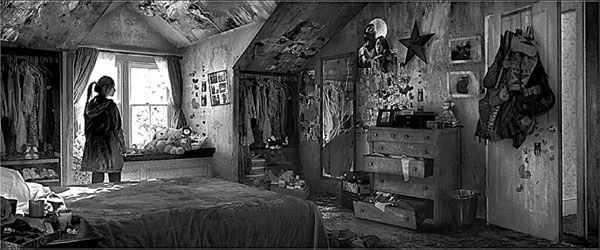Pixels in video games dot fine art's periphery
Updated: 2013-06-23 07:53
By Harold Goldberg(The New York Times)
|
|||||||||
|
"Into the Pixel" is a showcase for ambitious digital art. "Remembering Us," an image by the artist John Sweeney for a forthcoming video game, The Last of Us. John Sweeney |
LOS ANGELES - The annual E3 convention here is known for the premiere of video games with huge budgets, and for its boisterous hustle and bustle. But tucked between the two rowdy convention halls is a quieter area resembling a New York art gallery.
This is the site of the "Into the Pixel" exhibition, a juried collection of 16 digital artworks printed on canvas and plucked from the kinds of video games being marketed nearby. Those who stumble upon these works can perhaps glean some untold secrets, since the images are from games yet to be released.
Recent exhibitions at the Museum of Modern Art in New York and the Smithsonian American Art Museum in Washington have considered such art in a different light, focusing on each video game as a whole.
"The thing is, these people are not computer geeks - they're real artists," said Martin Rae, the president of the Academy of Interactive Arts & Sciences, which produces the show with the Entertainment Software Association.
When "Into the Pixel" began in 2004, industry executives were seeking a way to celebrate E3's 10th anniversary. It was an opportune time because the industry had begun to turn out personal computers and game consoles with more powerful graphics processors that allowed artists to put forth their wildest dreams. With far richer textures, shadowing and highlighting, they could begin to fashion something more akin to reality in their virtual worlds.
For the current competition, more than 200 works were submitted digitally, including "Remembering Us," an image by the artist John Sweeney for a forthcoming video game, The Last of Us. Each work was considered and rated by a jury of seven members.
Jon Gibson, the cultural entrepreneur behind the iam8bit production company and a curator of the show, describes "Into the Pixel" as a sort of hall of fame.
"These artists usually work quietly and unknown in very secure cubicle environments," he said. "It was important to us to give them the respect they deserve."
Over the years, the jury has included movie producers and curators from the art world in an effort to raise the profile of the works.
The juror Patricia Lanza, the director of talent and content at the Annenberg Space for Photography in Los Angeles, said she was drawn to well-executed pieces that appealed to her emotionally. "It's illustration art at its finest level. Is it real fine art? Some of it could get to that place," she said. "Some pieces were extraordinary, really."
One work on which the jury immediately agreed was "Back From the Wild," an image from Destiny, a forthcoming game from Activision and Bungie, the creators of the best-selling Halo series. The piece, by the Bungie illustrator Jaime Jones, depicts an armor-clad robot-like character with a splash of blood on his head. Mr. Jones said he was going for a level of incongruity and wanted people to ask, "Why is this robotic form feeling tired?"
Other images do not look quite as fierce or foreboding. Nathan Stapley, who has worked with the veteran game designer Tim Schafer (Psychonauts, Grim Fandango) since 1999, executed a painting for the game Broken Age that evokes the dreamy fantasy and youthful isolation of a children's picture book.
"Broken Age will be an old-school 2-D adventure game," Mr. Stapley said. "The boy you see is living in a matriarchal spaceship, a very regulated environment. The girl is trapped in her village, and she's going to be the sacrifice at a tribal ceremony. I wanted to show that they are living parallel lives."
After their debut at E3, the works will be presented at other video game shows, like PAX, an event opening August 30 in Seattle, Washington. Mr. Rae of the Academy of Interactive Arts & Sciences said he hopes that conventional galleries ultimately will be part of the "Into the Pixel" tour.
Ted Price, the president of Insomniac Games, which made the Ratchet & Clank and Resistance series, pronounced the show a "fine art exhibit." It could, he said, "bring a whole new generation to museums."
The New York Times
(China Daily 06/23/2013 page12)
